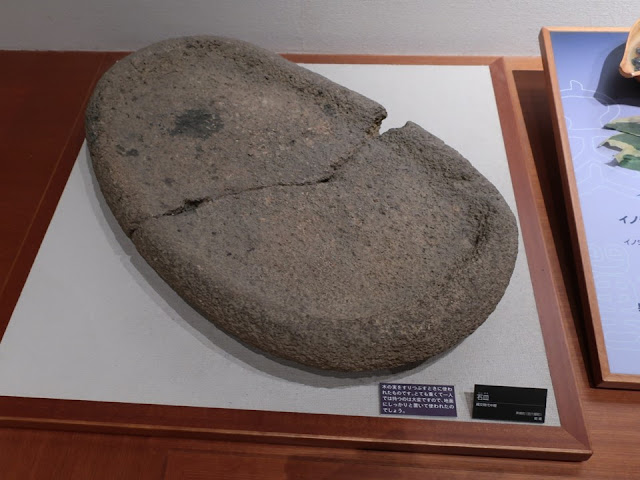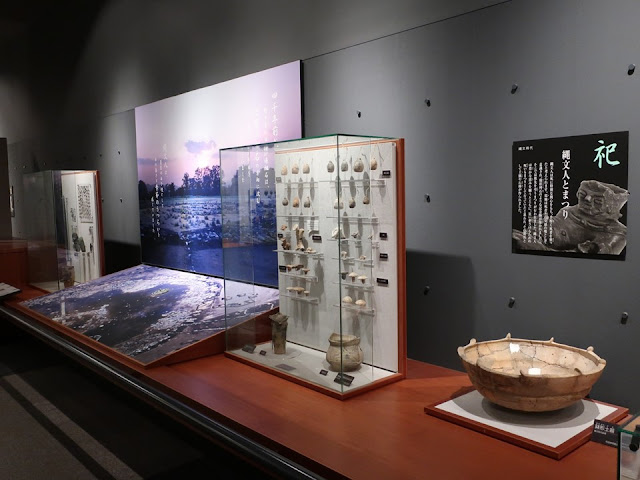Akita is located in northern Japan, and its prefectural museum is huge. It shows a lot of exhibits about “Human History” which is the history of ordinary people in Akita. The staff said that they prioritize on ordinary livelihood; it is what I focus on. I took photo under the approval of the museum office.
とても大きな博物館です。私のお目当ての「人々の暮らし」(人文展示室)の展示が充実しています。「人文」を「Human History 」と訳しているし、解説員さんの言葉からも、暮らしの展示に重点を置いていることが良く分かりました。特別利用申請をして撮影しました。
The large entrance suits to prefectural museum. It is in Akita Prefectural Koizumigata Park.
県立らしい構えです。秋田県立小泉潟公園の中にあります。
Human History Exhibition Hall、人文展示室
“Shouki-sama” is set in front of the hall. It is a powerful being which protects a village from an invasion of disease and disaster. People stand it at the border of their village and pray.
On the 14th of September, people
take out two Shouki-sama (male and female) from the small shrine and change
their outfits which are made of Japanese cedar (Sugi) leaves. Then, men carry
them and walk around the village. The families in the village offer sake
(alcohol) or dango (rice dumpling), and pull out the cedar leaf which is a
talisman. People set the leaf at the entrance of their house. On the storm day, they smoke it in order
to prevent from disaster.
Then, people keep Shouki-sama inside the
shrine. They stand facing each other. People play music and chant at that time
in order to pray for the safety of the village.
入口に置かれているのは、なまはげではなくて、ショウキサマ(鍾馗様)。集落の境に大きな人形を立てて、病気や災いから集落を守ってもらうそうです。
9月14日に、男女のショウキサマを祠から出して、衣替えをします。杉の葉の衣装を着替えた後、若い衆がショウキサマを背負い、集落内を廻ります。家々は、お酒やお団子をお供えし、ショウキサマの杉の葉を抜きます。杉の葉が、魔除け、風除けになり、戸口に指したり、嵐の時にいぶしたりします。
ショウキサマを祠に納める時は、男女二体を向かい合わせにし、笛や太鼓ではやしたて、念仏を唱えて、集落の無事を祈願するそうです。鹿島様や仁王様などとも呼ばれているそうです。
ショウキサマ作り:https://www.sakigake.jp/news/article/20200621AK0022/
The exhibits in the right side of “Human History Exhibition Hall” are almost about the ancient period. Those on the other side are after the medieval period.
I highlight exhibits of the Jomon period (from 13,000 years ago to 2,300 years ago) on this article. The theme is “Blessing of forests, and pray to sundial”.
人文展示室内は、右半分がほぼ古代、左半分が中世以降の展示です。
縄文時代(13,000年前から2,300年前)「森のめぐみ、日時計への祈り」を中心にアップします。住居の中に入れます。
Jomon period、縄文時代
After the cold era, people got blessings from forests.
寒冷な時代が終わり、森がめぐみをくれる時代になりました。
Seasonal food: Rice farming didn’t transfer to Japan, so people hunted or gathered foodstuff and preserved them. Before seeing this exhibit, I reckoned they ate terrible meals, but I was wrong. There was various foodstuff near at hand. As a preserving method, a pit is introduced. Baking by means of hot stones and removing the astringent taste by water are introduced as cooking methods.
季節の食材:稲作はまだです。狩りと採集で得たの食べ物を保存して食べます。ひどいものだろうと思っていましたが、こうして見ると身の回りに食材はありますね。保存と調理として、貯蔵穴、加熱(火を焚くのと石焼き)、水さらし(木の実の渋み抜き)が紹介されていました。
Spring meals and recipes (Hamburger steak of venison and tochi-nuts and a soup): A family shared the meal in a pit-dwelling house. It was a very happy dinner time, I’m sure. Spring plants are the main ingredient of the soup. People were undoubtedly pleased that plants started sprouting.
春の料理とレシピ:これをひと間の竪穴住居で食べるのだから、「今日もおまんまにありつけて良かったね」というような会話になったのでしょう。何よりも、ウドなど植物=食べ物が芽生えてきたことが嬉しいでしょうね。
Summer meals and recipes (Steamed fish and a soup): A tai fish is wrapped by aromatic leaves and is steamed in a clay pot with shell fish and sea water around half an hour. Our ancestors were also eager to eat delicious food. They enjoyed taste of shell fish, so it was not just a food, it was a meal. Seaweed was an ingredient of the soup.
夏の料理とレシピ:土器に海水と朴の葉で包んだ鯛を入れ、貝を加えて30分ほど蒸すそうです。ご先祖様も美味しいものが食べたかったし、料理のセンスの良い人も居たでしょう。もっと美味しい料理を作っていたかも。貝の旨味をしっかり出して、餌じゃないですね。
Autumn meals and recipes (Hamburger steak of bird meat and chestnuts. Dessert of nuts.): It is a harvest season. I guess they ate not only hamburger steak but also roasted fish, stew, smoked food, fermented food and so on. People tend to pursue good taste.
秋の料理とレシピ:実りの秋です。ハンバーグだけじゃなく、たたきやシチュー、燻製、発酵製品、もっと味を求めていたように思います。
Winter meals and recipes (Grilled wild boar meat, hamburger of venison and acorns, and fruit liquor): It says that main ingredient was meat which was hunted. Akita is in a snowy region, so I think they had a preservation method such as keeping in salt or fermentation.
冬の料理とレシピ:刈りで捕れた動物の肉を主とする食事とあります。今の秋田は雪国です。冬に備えて塩漬けや発酵を含めた保存技術が進んでいたのではないでしょうか。
Btw, the meals were assumed scientifically
based on chemical analysis of clay pot’s deposits and so on. It's great!
I'm sure that eating and chatting were fun for Jomon people.
土器の付着物の化学分析結果などから食べ物や生活を推定したそうです。すごいですね。
食べること、だべることは縄文人の大きな楽しみで間違いないと思います。
The stone platter was used to grind nuts. I can easily picture out the people crashing nuts.
石皿(縄文中期)は、木の実をすりつぶす時に使われました。この石で、せっせと調理していたのですねえ。
People prayed for the deceased, blessings of nature and safety. Many ritual instruments are in the display rack. Those are simple and beautiful. Two photos are uploaded below.
そして、祀り。死者の弔い、自然の恵みや安全を願ってのまじないもありました。中央のケースに、素敵な祭祀用品があります。素朴です。
Clay mushrooms are pretty. A mushroom reminds of a penis, so it is a symbol of prosperity of descendants and longevity, it says.
キノコ形土製品:可愛い。キノコは男根に通じ、子孫繁栄と長寿を象徴しているそうです。
The photo above is sundial shape stones. It is written that Jomon people thought the summer solstice was the boundary of the change of seasons. I agree. On the day, the sun rises in the center of the stone circle in Ohuyu, Akita.
日時計様組石:縄文人は、夏至を境として季節を感じていたとあります。確かに、大湯の環状列石も夏至の日に、一直線に光りが通るようになっています。
Accessories and an attached clay doll, so cute.
アクセサリーを付けた土偶も展示されています。
These unique shape clay dolls would be for a ritual. I think it was a fun time for a craftsman and spectators.
個性的な土偶。祭祀の用具だと思いますが、作った人、それを見た人、その時の反応、楽しい時を感じます。
These little clay dolls are for ordinary people, I reckon.
小さな土偶。庶民用なのでしょうか。
Valuable clay pots are in the display case. The lower pot has a human face shaped spout. It’s a work of art.
Eating, talking, loving family, owning good objects and so on, are eternal fun of people.
縄文時代の土器。下は、人面付環状注口土器(縄文後期、潟上市)。美術品です。
食べる、話す、家族を大切にする、良い物を持つ、など人々の楽しみは、今と変わりません。
Yayoi and Kofun (Large grave) period (from 2,300 years ago to 1,300 years ago), “Villagers and rice field, and mountain people”
弥生・古墳時代(2300年前~1300年前)、「水田にうつる里人と山人の姿」
Akita is in a cool region, therefore hunting and gathering foodstuff were important livelihoods until the rice farming was established. The influence of Yamato Dynasty which is led by Tennou (emperor) reached Akita.
秋田は寒いので、米作りが定着するまで、狩猟・採集と稲作の併用でした。大和朝廷の影響も出始めます。
To tell the truth, I’m not interested in
the prehistoric age. Because scholars imagine ancient lives just as they like, I
felt. However, the food and lives are assumed based on scientific grounds in
this museum. It is very convincing.
I know it is difficult to know how people
enjoyed lives which is my purpose to visit a museum. But I could speculate
their lives here. It is an incredible exhibition.
私は、文字がなかった先史時代は、言いたい放題な感じがして好きではなかったのですが、ここでは、科学的に食べ物や生活を推定した結果を展示してあって、納得でき、かつ、人々の生活をイメージできました。江戸時代、明治時代と違って何をして楽しんでいたか、という推測は容易ではないですが、とにかく、圧倒的な展示です。
Visited in October, 2020
Official website: https://www.akihaku.jp/english-page.htm
https://www.akihaku.jp/ (in Japanese, but
much more info.), accessed in June, 2021
Previous post (Namahage, very exciting year-end rite in Akita):
Next post (part2
of this museum):
Akita Prefectural Museum (2/2)、秋田県立博物館(2/2)
























Comments
Post a Comment